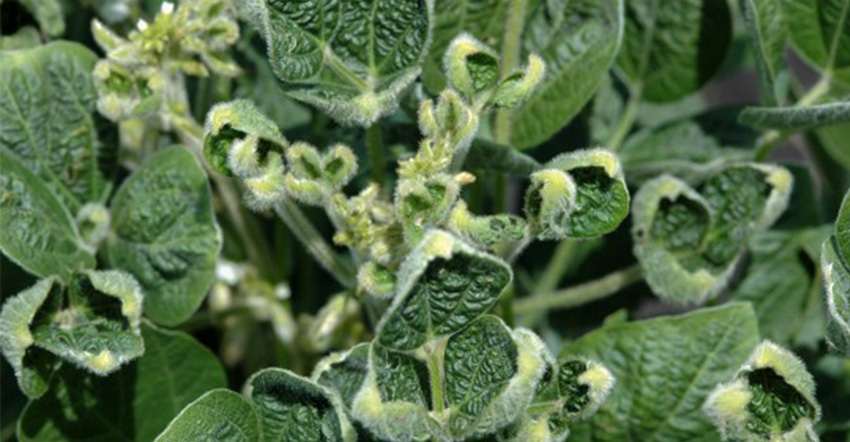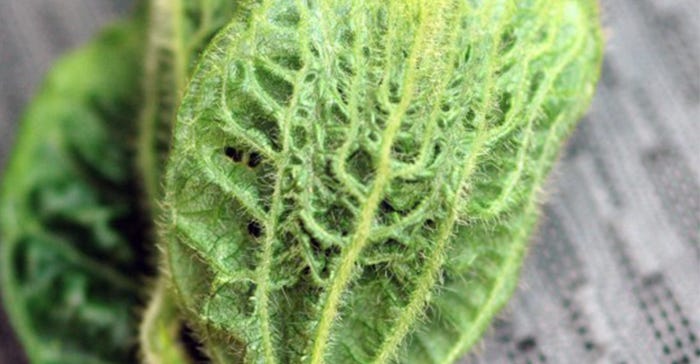
So your bean leaves are cupping, the plants are stunting and you’re pretty sure you have dicamba injury. What do you do next?
Step one, says agronomist Karen Corrigan, McGillicuddy Corrigan Agronomics, is to diagnose your field first. “If you can’t do that yourself, call your seed agronomist or co-op agronomist or somebody. Start from there.”
University of Illinois weed scientist Aaron Hager offers up a look at the symptoms of dicamba exposure:
• Extreme cupping of trifoliolate leaves, most pronounced on the upper trifoliolates.
• Veins of affected leaves tend to assume parallel orientation instead of the usual net venation pattern.
• Tips of cupped leaves with parallel veins are often brown or cream-colored.
• Plants are stunted as compared to plants not demonstrating the aforementioned symptoms; these plants may sometimes remain stunted the remainder of the season.
• Depending on time and dose of exposure, pod development can be adversely affected.
“Other factors can cause leaf distortions, but I am not aware of anything other than dicamba that causes these symptoms collectively,” Hager says.
 PARALLEL: Hager says veins of young, affected leaves assume a parallel orientation following exposure to dicamba. (Photo by Aaron Hager, University of Illinois)
PARALLEL: Hager says veins of young, affected leaves assume a parallel orientation following exposure to dicamba. (Photo by Aaron Hager, University of Illinois)

Next up: Identify the source, if possible. Talk to the neighboring farmer or the retailer who made the application directly. “Try that avenue first. If that doesn’t get you anywhere or if there’s denial, that’s when I would call the state and file a complaint,” Corrigan says.
Hager agrees. “Try to work it out or, if you’re not getting anywhere, you have every right to file a formal complaint.”
And if you can’t identify the source — particularly if you suspect the dicamba volatized and came in from an unknown source — file a complaint with the Illinois Department of Agriculture.
Farmers or individuals may file a complaint by filling out and submitting the pesticide drift complaint form or by calling IDOA’s Bureau of Environmental Programs at 800-641-3934 (voice and TDD) or 217-785-2427. Complaints must be filed within 30 days of the incident or within 30 days from when damage was first identified.
“In a lot of cases, the farmers are friends and they’re waiting until harvest to do yield checks,” Corrigan says. Others called their insurance agent and are letting liability insurance handle it.
“Usually, you can talk it out with someone, although some are adamant the product they used doesn’t move. Your only option then is to contact the state,” she adds.
If you think you may have a liability claim, Dave Brown, Insurance Providers Group, recommends taking several dated photos. Write down observations and conversations regarding the situation, and be prepared to show comparative yield data, Brown says. Time-stamp records by emailing the photos and notes to yourself for a trackable history.
And if you’re the one getting called and questioned about your own dicamba movement? Corrigan recommends reading up on symptomology and going through the dicamba application checklist. “Pull your weather data for change in wind direction or an inversion, too,” she adds.
Make sure you understand the difference between volatility drift and temperature inversion drift. Larry Steckel at the University of Tennessee offers a clear explanation in this video.
For further dicamba information, check out these stories:
Does dicamba drift cause yield loss?
8 things about temperature inversion you should know now
Dicamba injury and insurance: 6 things to consider
A day in the life with dicamba damage
Dicamba: what’s happening in Illinois
About the Author(s)
You May Also Like






